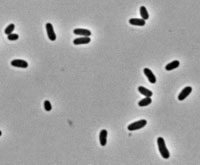Corynebacterium species - Overview
| Corynebacterium | |
|---|---|
| Phylum | Actinobacteria |
| Order | Actinomycetales |
| Family | Corynebacteriaceae |
| Genus | Corynebacterium |
Overview
The Corynebacterium bacteria are common inhabitants of skin and mucous membranes of animals. They may cause opportunistic, pyogenic infections. Most species are host specific.
Characteristics
The Corynebacterium are small, tough, non-motile, Gram positive rods. They are pleomorphic and cluster together to resemble Chinese characters - coryneform morphology. They are known as diphtheroids and are catalase positive and oxidase negative. They are facultative anaerobes and require enriched media for growth.
Pathogenesis
The Corynebacterium species are pyogenic, causing suppurative infections except for C. bovis.
Diagnosis
To diagnose the Corynebacterium species, samples include pus, exudate, affected tissues and urine. The presence of coryneform organisms in smears is diagnostic. Culture on blood agar, selective blood agar and MacConkey agar are also diagnostic, they do not grow on MacConkey.
See here for a list of Corynebacterium species
| Corynebacterium species - Overview Learning Resources | |
|---|---|
 Search for recent publications via CAB Abstract (CABI log in required) |
Corynebacterium spp. publications since 2000 |
| This article has been peer reviewed but is awaiting expert review. If you would like to help with this, please see more information about expert reviewing. |
Error in widget FBRecommend: unable to write file /var/www/wikivet.net/extensions/Widgets/compiled_templates/wrt665d4e12a98784_08782084 Error in widget google+: unable to write file /var/www/wikivet.net/extensions/Widgets/compiled_templates/wrt665d4e12aee8e7_00266932 Error in widget TwitterTweet: unable to write file /var/www/wikivet.net/extensions/Widgets/compiled_templates/wrt665d4e12b4caf6_57591193
|
| WikiVet® Introduction - Help WikiVet - Report a Problem |
